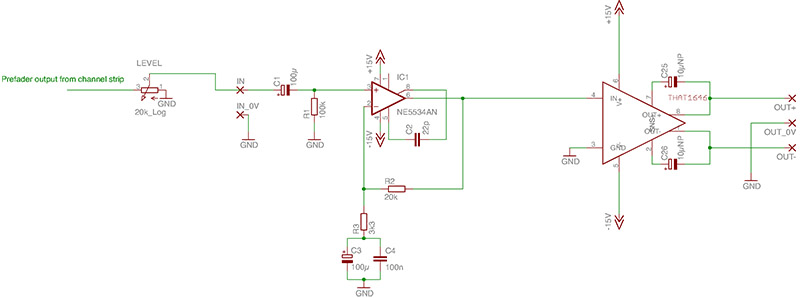saint gillis
Well-known member
Hi mates, I ve put in a rack two Studer 900 channel strips, here's the schematic
http://img839.imageshack.us/img839/6312/26lm.jpg
I took the Pre-Fader output ( just next to "Low Equalizer" on the schematic" )
But it is a 0db output, so I need to convert it to a balanced +6db output, first of all I ve tried to duplicate the circuit used in the Studer 900 's faders :

Unfortunately I had an offset problem, positive output with much more gain than negative output, rather than trying to adjust the resistors values I tried an other design, here it is:
The Pre-Fader output goes throught a 22KLog "Level" pot then to this circuit :
http://img541.imageshack.us/img541/5875/vt4w.jpg
There is an amplifying stage calculated to get the same input and output line levels when the 22kLog pot added is at its mid-point, then a mixed feedback driving circuit for a LL2811 output transformer wired in 1:2.
My problem is that I sometimes got some kind of auto-oscillation at the output, when I switch the device off and on everything comes back to a normal behaviour and the sound is perfect, any advice?
http://img839.imageshack.us/img839/6312/26lm.jpg
I took the Pre-Fader output ( just next to "Low Equalizer" on the schematic" )
But it is a 0db output, so I need to convert it to a balanced +6db output, first of all I ve tried to duplicate the circuit used in the Studer 900 's faders :

Unfortunately I had an offset problem, positive output with much more gain than negative output, rather than trying to adjust the resistors values I tried an other design, here it is:
The Pre-Fader output goes throught a 22KLog "Level" pot then to this circuit :
http://img541.imageshack.us/img541/5875/vt4w.jpg
There is an amplifying stage calculated to get the same input and output line levels when the 22kLog pot added is at its mid-point, then a mixed feedback driving circuit for a LL2811 output transformer wired in 1:2.
My problem is that I sometimes got some kind of auto-oscillation at the output, when I switch the device off and on everything comes back to a normal behaviour and the sound is perfect, any advice?





